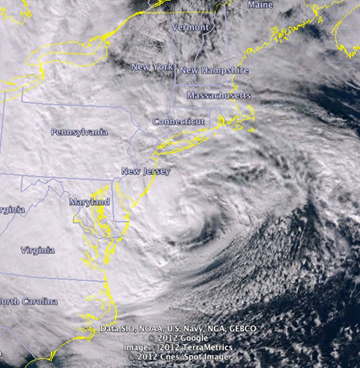- Home
- About
- Stakeholders
- Projects
- Water
- Evaluating reservoir operations and the impacts of climate change in the Connecticut River Basin
- Collaborative development of climate information for the Connecticut River Basin using Shared Vision Forecasting
- Impacts of climate change on the Massachusetts Water Resources Authority water supply system
- Climate information for water harvesting and re-use strategies in urban settings
- Delaware River streamflow reconstruction using tree rings
- Coasts
- Health
- Cross-cutting theme: Climate
- Cross-cutting theme: Vulnerability/Evaluation
- Water
- Library
- Resources
- Seminars
- Contact Us

Hurricane Sandy
When Tropical Storm Sandy was born on Monday, October 22, 2012, several weather forecast models were already suggesting that it could become a major coastal storm for the East Coast. Just two days later, tracking northward from the Caribbean Sea, Sandy strengthened into a Category 1 hurricane. After inflicting some considerable damage to Jamaica, Cuba, and the Central Bahamas, Sandy set her sights on the east coast of the United States.
 By Saturday, October 27, with weather forecast model guidance predicting landfall near the southern coast of New Jersey, authorities in the Northeast began to take action. The states of New Jersey and New York both declared a state of emergency, and cities in the region began their emergency management preparations. As Sandy drew closer, New York City issued evacuation orders for high-risk flood zones, closed parks, and suspended mass transit. In New Jersey, the barrier islands along the shore were evacuated, and reservoir levels were dropped to reduce the risk of inland flooding. All the states in the region activated shelters, expanded their emergency forces, and prepared their local landscapes for the extreme conditions expected from Sandy. Likewise, utility companies set out to protect their infrastructure, and planned for systematic power shutdowns and blackouts; work crews from regions unaffected by Sandy were contracted to help deal with repairs after the storm.
By Saturday, October 27, with weather forecast model guidance predicting landfall near the southern coast of New Jersey, authorities in the Northeast began to take action. The states of New Jersey and New York both declared a state of emergency, and cities in the region began their emergency management preparations. As Sandy drew closer, New York City issued evacuation orders for high-risk flood zones, closed parks, and suspended mass transit. In New Jersey, the barrier islands along the shore were evacuated, and reservoir levels were dropped to reduce the risk of inland flooding. All the states in the region activated shelters, expanded their emergency forces, and prepared their local landscapes for the extreme conditions expected from Sandy. Likewise, utility companies set out to protect their infrastructure, and planned for systematic power shutdowns and blackouts; work crews from regions unaffected by Sandy were contracted to help deal with repairs after the storm.
On Monday, October 29, Sandy made landfall along the coast of southern New Jersey as an extra-tropical storm, breaking records along the way. Sandy set an all-time record for lowest central pressure (a measure of storm intensity) at landfall of any east coast storm north of Cape Hatteras, NC. The sheer size of the area affected by storm/tropical storm force winds of 39 mph or greater expanded to nearly 500 miles - also remarkable, and a major contributor to the damage in the region, as violent winds and periods of heavy rainfall lashed coastal locations for several hours. In an unfortunate coincidence, Sandy came ashore near the time of high astronomical tide in the New York City metropolitan area, contributing to catastrophic coastal flooding. A wind gust of 90 mph was recorded in Islip, New York, and wind gusts of over 60 mph were recorded at all three major airports in the New York City region. The surge at the Battery was 13.88 feet, the highest ever recorded at that location, and a buoy south of New York City reported a wave height of 34 feet, the second highest Sandy-induced wave height recorded anywhere.
By morning on October 30, the extent of the devastation was becoming clear. More than 4 million people lost power. Low-lying areas, including parts of lower Manhattan, southern Brooklyn and southern Queens were flooded, in some cases beyond the extent of the evacuated zones, and a coastline was changed forever. Downed trees blocked roadways, making them impassible to emergency vehicles. Severed gas lines became an additional hazard, with fires sparked in several areas, most notably the Breezy Point section of the Rockaways in Queens. Public transportation in the NY-NJ metro area was literally dead in the water for a time, with several tunnels under the Hudson and East Rivers flooded to the brim.
Preliminary estimates suggest that at least 100 deaths in the U.S. alone resulted from Sandy, with a price tag on damage that could exceed $50 billion. More than 20,000 people in New York City alone may have been made homeless by the storm, and more than 40 public schools in the City remained closed for the school year due to building damage.
The recovery process is well under way. During the first week after the storm, most subway and commuter rail service was restored, and power was restored to a majority of the population. But major challenges remain, especially for coastal populations, and will for some time to come.
Sandy has also energized discussions about New York City's vulnerability to climate, as well as possible adaptation solutions. Please see the other links in this section to learn more about the CCRUN team's activities related to Sandy.
